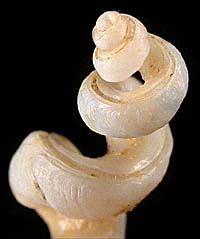|
< Previous family introduction |
|
|||||
 |
Family Siliquariidae Slit worm shells
|
|||||
|
At first sight the slit worm shells may not be recognized as molluscs at all, as they do not obviously show the typical coiled gastropod shape, and can easily be mistaken for the shells of polychaete worms (Serpulidae). However, on closer investigation of the animal it is apparent that they are typical molluscs, with the molluscan head, foot, and radula. They are very closely related to the Turritellidae in structure, being little more than turritellids that have uncoiled and taken on a life fixed to the substrate. A slit or series of elliptical holes runs the length of the shell. The slit or holes may be closed by a thin, shelly layer deposited inside the shell. Siliquariids live in a sedentary position subtidally or less frequently intertidally, embedded in clumps in sponge, which provides physical support and protection from predators. The apex of the shell is embedded within the sponge, and the open end of the shell protrudes out into clear water. Microscopic food particles are filtered from the water by the ctenidium, which had added food capture to its normal respiratory function. Food particles embedded in a mucus string are moved by cilia to the mouth. A corneous operculum closes the shell when the animal withdraws. The siliquariid animal has the basic molluscan structures modified to suit its lifestyle. The foot is much reduced, its only function being to support the operculum. The radula is reduced, and instead of scraping and rasping for food, it is used only to pull in the mucus food string. The operculum is covered with bristles of various shapes and acts as a filter, removing large particles to prevent them clogging the ctenidium. Species of Siliquariidae tend to look very similar in shell morphology. One of the most useful character for species differentiation is the opercular bristles, which may by elaborately forked. The slit or series of holes is also diagnostic of species, but the same species may show different slit shapes in different sponge species. Six species are now recognized from NSW. Three of these were listed in Iredale & McMichael's (1962) list of NSW Mollusca; two of them being common and widespread throughout southern Australia, while the other is known from only two specimens from Sydney Harbour. The other three species are newly recorded in the NSW fauna. They are tropical Indo-West Pacific species for which NSW is the southern limit of their range. Family Reference There has been no revision of the family in Australia and there is no modern comprehensive reference. The Japanese species are figured in Marine Molluscs in Japan (Okutani, 2000). Schiaparelli (2002) has reviewed the eastern Atlantic and Mediterranean species. Bieler (2004) has described the functional morphology of the family, concentrating on west Atlantic species, describing how the operculum operates in conjunction with the slit to manage water flow and waste. Pansini et al (1999) has reported on the relationship between siliquariids and their host sponges. Coverage: All the named species that occur in NSW are detailed here. There are several other small unidentified or unnamed NSW species in the Museum collection. Identification notes Shells are recognized as belonging to the Siliquariidae by being uncoiled to a smaller or greater degree, but usually with the first few whorls coiled. Most of the siliquariids have a longitudinal slit, or a series of elliptical holes. In the unrelated family Vermetidae, which is also uncoiled, there is no slit. But the genus Stephopoma, in the Siliquariidae, has a shell without a slit, and in this case the recognition is by structure of the animal, operculum or protoconch. In NSW all species have slits or holes, except Stephopoma tricuspe. There are polychaete worms that build calcareous shells that may be confused with siliquariids and vermetids. The polychaete Galeolaria caespitosa occurs in dense masses of entwined tubes below the mid-tide level in NSW, and empty and broken tubes litter the beaches. For this species tube length is 16-25 mm, with diameter of 2-3 mm. These shells are not coiled, and are only slightly tapered. Acknowledgements Dr Stefano Schiaparelli and Dr Richard Willan reviewed and substantially improved this section. Mr Ian Loch provided advice and facilitated access to the Museum collection.
|